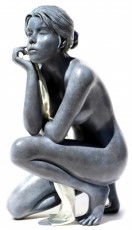
An exhibition… on the exhibition of future impressionists

About the exhibition “Paris 1874. Inventing Impressionism”, visible at the Musée d’Orsay in Paris from March 26 to July 14, then at the National Gallery of Art in Washington from September 8 to January 19.
If you don't yet know that Impressionism is 150 years old, it's because you've just come out of your cave, from a long retreat at the convent or from the moon! The celebration of this anniversary is indeed almost everywhere. And not only on the front page of Connaissance des arts magazine this March, which devotes beautiful, nicely illustrated pages to the event. The brilliant idea of crowning the major exhibition at the Orsay Museum with loans of Impressionist, pre, post or para-Impressionist works of art throughout France ensures increased promotion of the event. No less than one hundred and seventy-eight works are currently on loan to thirty-four partner institutions, spread across thirteen regions. Please note, as with Cinderella, there is one condition for this exceptional release: the works of art must all be back in Paris before the opening of the Olympic Games! However, you should not overdo it...
In short, take a look at the museum closest to you: there may be a painting on temporary exhibition to tell you about Impressionism in general, and its relationship with the artistic movement and the region in particular. For example, I had parked my caravan in Amiens last weekend, when I came face to face at the Musée de Picardie with Pierre Stépanoff, no more and no less the director of the establishment, in the process of speaking very brilliantly in front of a passionate crowd on the beginnings of impressionism and seaside leisure, in front of the very beautiful painting by Edouard Manet just hung the day before, On the beach, painted in Berck-les-Bains, a well-known vacation spot for Amiens residents. A painting whose legend says that grains of sand were even encrusted in the paint... Which the director of the Picardie museum hardly believes, knowing Manet well enough to affirm that the painter, even if he perhaps actually started his painting in the open air, necessarily completed it in the comfort of his studio. Without risking the slightest grain of sand stopping the wheels of its meticulous know-how.
The fatal gaze of Berthe Morisot in Manet's Le Balcon overlooks the Bordeaux quays of the Garonne and Le Citron by the same Manet completes the annual harvest of the orange tree garden of the Villa Medici, this French enclave of Rome. Monet's Rouen Cathedral visits its neighbor in Le Havre, his Magpie flew to Clermont-Ferrand, the flags of his Rue Montorgueil fly in Douai, his Déjeuner sur l'herbe spreads its tablecloth in Besançon, and two examples of his beloved water lilies have left the banks of the Seine to anchor on the banks of the Eure and in Corsican waters. Renoir's The Reader went to Albi to turn its pages, Caillebotte's The Boat Party sailed to Nantes and Van Gogh's Starry Night illuminates the sky of Arles where it was painted... So it was we are making the 150 years of impressionism a true national celebration!
But the exhibition “Paris 1874. Inventing Impressionism” is not yet another exhibition on Impressionism. It is “an exhibition on the 1874 exhibition”, as Christophe Leribault, the president of the Orsay and Orangerie museums, points out. And it’s still at the Musée d’Orsay that you’ll have to go see it. In my opinion, by booking well in advance to be sure of getting in on the one hand, and because you absolutely have to register to experience the immersive expedition on the other hand. Yes, the second brilliant idea of the Musée d'Orsay is to have entrusted Excurio and Gédéon Expériences with the task of creating a tour of the famous 1874 exhibition in virtual reality. We therefore find ourselves for 45 minutes in the middle of the opening in the salons of the photographer Nadar, which became an art gallery for the occasion, boulevard des Capucines, on April 16, 1874, strolling by the light of gas lamps in the middle of a multitude of works of art for sale hung haphazardly on walls hung in red, in the hubbub of harsh comments and criticism welcoming this strange new, slightly blurry painting that we don't call him impressionist yet. And which is shown here alongside the paintings of more conservative artists like Gérôme, Alma-Tadema, Ferdinand Humbert, Gervex, Detaille and other Albert Maignan…
You have to imagine Paris at the end of the 19th century. The City of Lights, the city of lively cafés, the capital of the arts, which in 1874 became the scene of an unprecedented artistic revolution. But who doesn't know it yet. The exhibition "Paris 1874 - Inventing Impressionism" celebrates this pivotal year when a group of daring painters shook the foundations of traditional art to create a movement that would forever change the face of painting: impressionism.
Located in the heart of the Musée d'Orsay, this captivating exhibition immerses us in the artistic excitement of 19th century France. Through a careful selection of emblematic works and historical documents, visitors are transported to a time when society was teeming with change, when the streets of Paris were the scene of political, social and artistic revolutions.
The exhibition begins with a carefully crafted context, highlighting the political, economic and cultural conditions that set the stage for the emergence of Impressionism. Visitors are invited to explore the neighborhoods of Paris where artists gathered, to frequent the cafés where innovative ideas circulated, and to discover the official art salons that stubbornly rejected new forms of expression.
At the heart of the exhibition is of course an exceptional collection of works by artists such as Claude Monet, Édouard Manet, Pierre-Auguste Renoir, Berthe Morisot, Alfred Sisley, Camille Pissarro, and Mary Cassatt. Iconic masterpieces, many on loan from American museums, are presented alongside lesser-known but equally revealing paintings of the diversity and vitality of emerging Impressionism. Walking through the rooms, visitors are invited to explore the revolutionary techniques used by the Impressionists to capture the immediacy of everyday life, the changing effects of light and color, and the fleeting moods of nature. From preparatory sketches to finished masterpieces, each work showcases the creative process and unique vision of its creator.
But the exhibition doesn't just celebrate the past; it also examines the lasting impact of Impressionism on modern and contemporary art. Dedicated rooms highlight the connections between Impressionism and other art movements, such as Post-Impressionism, Fauvism and Cubism, showing how the fresh ideas of these pioneers continued to inspire future generations of artists . In addition to the artworks, the exhibition offers a fascinating insight into daily life in Paris in 1874, through period photographs, satirical caricatures, and cultural artifacts. Visitors can thus better understand the social, economic and political context in which Impressionism took shape.
“Despite a scandalous success, the 1874 exhibition ended with a deficit of 3,713 francs,” reports Jérôme Coignard in Connaissance des arts. “An auction was therefore organized the following year. Despite the support of collectors such as Chocquet, De Bellio, Hoschedé, Caillebotte, despite the commitment of the critic Théodore Duret, it was a disaster. Apart from a few clairvoyant eccentrics, the public and amateurs were not ready to receive such innovative art. In their eyes, as in those of the comedian from “Charivari”, the small juxtaposed touches evoked the fake granite technique used by building painters! »
I also wonder if this bitter historical memory of lack of discernment has not traumatized art critics to the point that they no longer dare to criticize anything...
 Article written by Valibri in Roulotte
Article written by Valibri in Roulotte
Drawing :
Claude Monet - Poppies
1873
Oil on canvas
H. 50.0; L. 65.3 cm.
Donation by Etienne Moreau-Nélaton, 1906
© Musée d’Orsay, Dist. RMN-Grand Palais / Patrice Schmidt





































































